|
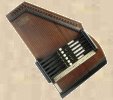  
Autoharp Gallery
Here are a few autoharps I own.
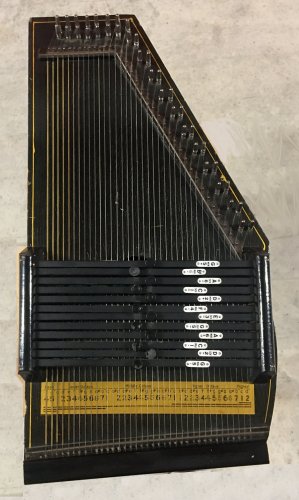 My first autoharp
This is an Oscar Schmidt 12 bar autoharp, probably a model 73. My first autoharp was very much like this one. I bought it sometime in the early 1960's. I didn't do much with the autoharp at this time, because I was concentrating on learning to play the 5-string banjo and the guitar. However, a brief acquaintance with the Stoneman Family, including Ernest "Pop" Stoneman, exposed me to a lot of things that had to do with the autoharp.
In particular, "Pop" Stoneman gave me a set of his special fingerpicks, which he made from springs taken from hair curlers.
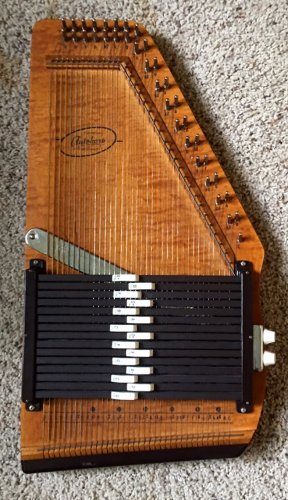 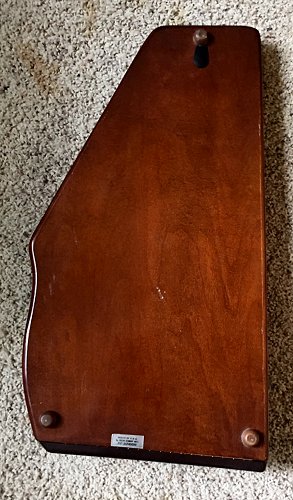
My First Serious Autoharp an OS 15
Roughly 1969, I was working with a group called "The Town and Country Trio." We had a small "show band" that played everything from folk music to rock, country-western, bluegrass, Tex-Mex, blues -- you name it, we probably did it. My instruments in this group were tenor banjo, 5-string banjo, keyboards, mandolin, guitar and saxophone. We decided to add another instrument for a special "flavor."
A friend of mine, the late Henry Slaughter, had worked out a particularly interesting arrangement of "Long Black Veil," which we found quite moving. I asked Henry if we could use his arrangement, and he agreed. Henry's arrangement featured the autoharp.
So, I purchased an autoharp that looked a lot like the one pictured above. The one in the photos is a Silvertone by Oscar Schmidt. The one I had at the time was an OS 15 A, which was basically the same instrument. Because the autoharp was not particularly loud, I added a DeArmond 1300 pickup like the one in the photo.
Amplification was the problem, though. I was playing my keyboards through a Leslie Pro 900 amplifier. I didn't want to purchase another amp. So I ran the autharp through the Leslie.
The Leslie Pro 900 amplifier has a pair of rotors that produce a myesterious throbbing effect when a switch is activated. The sound of the autoharp through that amplifier was amazing. And it set me on a path that I am still on today.
Note -- The Leslie Pro 900 is long gone. It was HUGE. It consisted of two large speaker cabinets, one on top of the other. It weighed 165 pounds, total. It was about 5 feet tall when the cavbinets were stacked upon one another. Total power was 100 watts. You could fill the Astrodome with that amplifier!
But when I was "between engagements," it was a problematic item to store. It certainly didn't match any of our living room furniture. Kismet separated me from the Pro 900. A friend of my brother "borrowed" it from me in 1979 and never returned it. It has since been replaced with an effects pedal that costs a tenth of the price of the original speaker, and that I can run through any amplifier.
In 1974, I left the "Town and Country Trio" and didn't perform much music for a while. But I still had a lot of fond memories.
My how things change!
In 2017, I decided to take up the autoharp again. So, instead of searching the internet for advice on choosing an autoharp, I blundered headlong into the world of modern autoharps. I decided to purchase what I thought would be a really fine instrument.
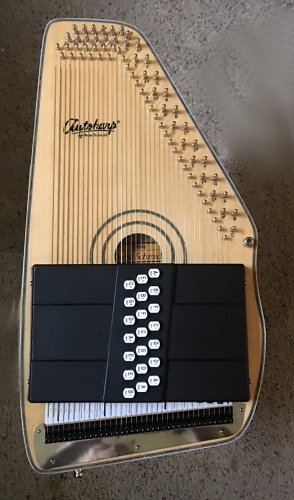 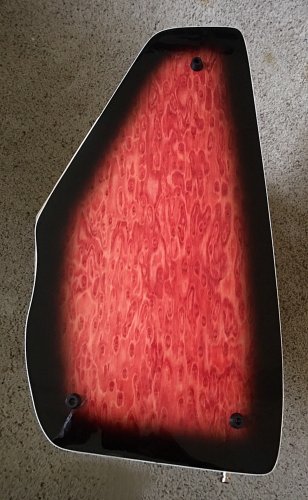
OS 120 21 Bar Autoharp
When I was an active autoharp player, back in the 1960's and 1970's, most of us played Oscar Schmidt autoharps. They weren't the only ones out there, but they were the easiest ones to find.
Houston wasn't exactly the center of the "Autoharp Universe," so we played what was available. Most of us steered clear of Silvertone and Airline instruments, which were actually made by Oscar Schmidt, but luthier made instruments were not very common here.
So I did some searching on the internet, and was impressed by this shiny
instrument that had things like fine tuners, which were basically nonexistent during the early 1960's, 21 bars, and a really pretty finish.
It looks and sounds like a fine piece of furniture.
But it didn't have as much power as the one I had played with The Town and Country Trio.
I wasn't impressed with its sound or the way it played. Some researche revealed to me that Oscar Schmidt was no longer a US-based company. The instruments were made overseas, and they just didn't have the "oompf" of the ones I had played years ago.
Some investigating on the internet caused me to realize that autoharps made in Asia were "also rans." Like this one, they were cranked out by the hundreds, and if you didn't purchase it from the right place, it might not be as good as it looked.
The top of this instrument is supposed to be solid Adirondack spruce, and the back is bird's eye maple. But it has a thick polyester coating that isn't very flexible.

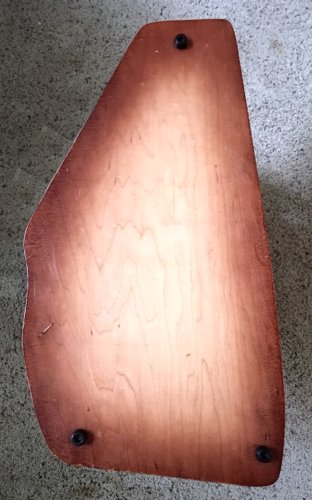
OS 21 C/R 21 Bar Autoharp (USA)
One of my favorite resources for used instruments is Reverb.com. You can find all sorts of stuff there.
I spotted this instrument, which was similar to the one I had played with the Town and Country Trio. The seller was Wellspring Music who advertised that they had been repairing and refurbishing autoharps for 30 years or so. I figured this would be a safe bet. it cost me about half what ""the piece of furniture" did, and when I got it, I was much more pleased with it.
The sound was fuller, and the action was much more agreeable. This was to be expected, because the instrument was made in the US, rather than overseas.
The pickup was an add-on that I purchased from ebay.
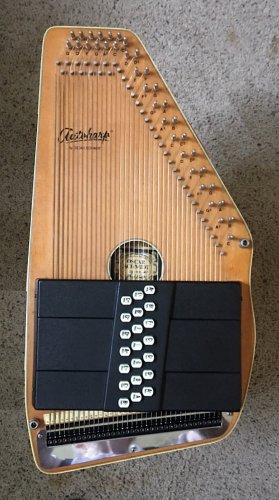

Oscar Schmidt OS 100 Centurion (USA)
In 1978, Oscar Schmidt began producing a limited number of finely-crafted 'harps for the professional market. These were called the "Centurion," and they featured solid spruce tops and solid mahogany backs. They were probably the finest autoharps Oscar Schmidt built as a production model.
Bob Lewis of Autoharp Works refurbished this one for me. He has them in stock from time to time. The fine tuners are made by Greg Schreiber, who also manufactures fine autoharps, pickups and strings. You will see one of his 'harps further down this page.
Bob Lewis also carries a full line of special parts to help you set your autoharp up for the best playing action.
This autoharp was the first really fine autoharp I purchased. It has a fine sound and a smooth action.

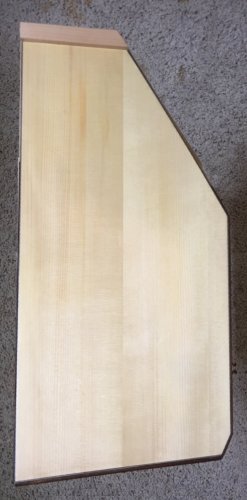
Whippoorwill Left-Handed Autoharp
This is the first "luthier built" autoharp I purchased. It was made by Ken Ellis of Whippoorwill Acoustics. The top is black walnut, the back is adirondack spruce and the trim is birdseye maple.
It has a customized string schedule with some extra bass strings added to it. Ken had this 'harp listed on Etsy.com, and I fell in love with it right away.
I needed a left-handed 'harp to play "Ozark style," with the instrument lying on a table. "Pop" Stoneman, who was my teacher, played with the 'harp lying on a box in his lap.
Ironically, some people think that playing the 'harp this way requires that you cross your hands. With a left-handed instrument, the hands line up the way they normally would on a right-handed 'harp, played in the "Appalachian" position.
Here's another very special left-handed autoharp.
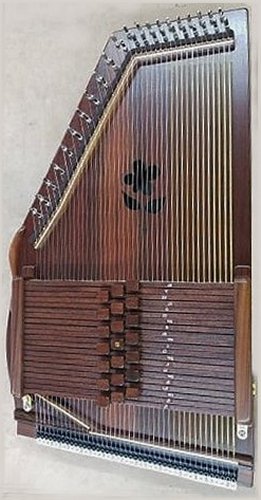 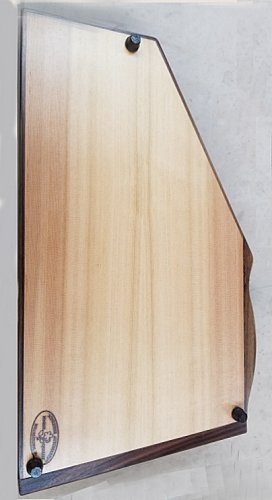
Schreiber Left-Handed Wide Body Autoharp
This is the first completely custom built luthier autoharp I have ever purchased. It has a rosewood top and a cedar back. It came with about a dozen extra chord bars for various special purposes. It has 42 strings, and it has a huge sound.
It was built for me in 2019 by Greg Schreiber. In October of 2018, I visited Greg's shop to get an idea of exactly what he manufactured. While I was there, I met the late Dr. George Orthey, who revolutionized the way autoharps are built. Greg learned a lot of what he knows from Dr. Orthey. It was a pleasure to meet both of them
While I was there, Greg showed me an instrument that he had built for his daughter. It was just like this one, as far as the woods are concerned. The sound was magnificent.
The main difference was that I wanted a left-handed instrument. The reason for the left-handed instrument is that I had some nerve damage in my left arm from a surgical procedure, so it is much easier for me to play with the autoharp on a table or my lap. This does not require any special changes in the way I play the instrument, because when you place a left-handed autoharp on the table, it puts the chord bars under the left hand, and the plucking area of the strings under the right hand, which is the same orientation of a right-handed 'harp being played in the traditional "Appalachian" style.
This instrument has a Schreiber magnetic pickup and Screiber fine tuners, as well.
A Couple of Interesting Luthier Built Instruments
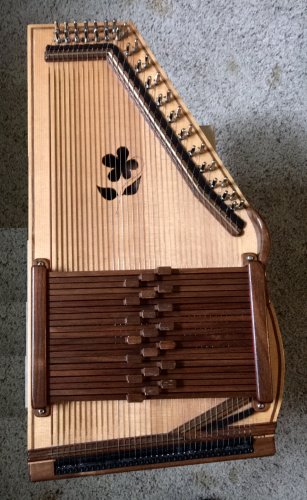 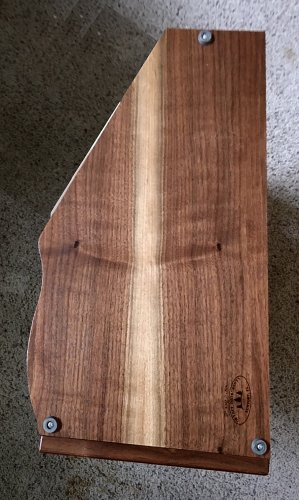
Orthey "Mary Lou Model"
Sometime in 2018, I saw this autoharp listed on a web site. Knowing the quality of Orthey harps, and realizing that Dr. Orthey was never going to make any more of them, I snarfed this one right up!
It needed very little work. This instrument has a set of Oscar Schmidt fine tuners. OS tuners come in sets of 36. This is a 37 string instrument. Oscar Schmidt eliminated the 37th string sometime around 1955. Dr. Orthey "reinstated" the 37th string. However, at the time this instrument was built, 37 string fine tuner sets were nonexistent. So there is no fine tuner on the low F string
Dr. Orthey named this model after his wife, who passed away in 2006. Dr. Orthey passed away in 2020.
Mary Lou Orthey was the compiler and editor of The Autoharp Owner's Manual, which is a compendium of articles from The Autoharp Quarterly. George Orthey wrote many of the articles in this book, and they show his extensive knowledge and excellent sense of humor.
These instruments are sought after by autoharpists world-wide.
Greg Schreiber acquired the righte to Dr. Orthey's work and is now producing wonderful autoharps in his shop, which is just down the road from Dr. Orthey's former residence.
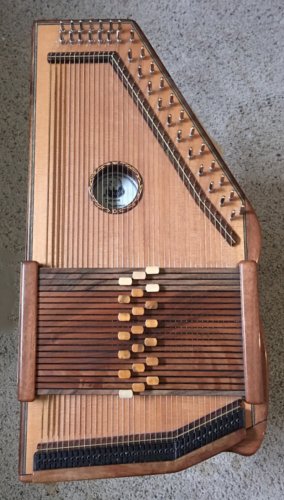 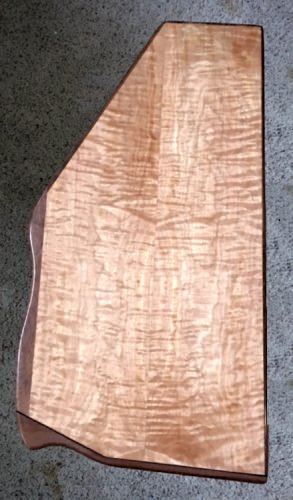
D'Aigle Cascade Model
In 2019, while browsing for autoharps, I saw this one listed on one of my favorite used instrument sites. Here was a chance to try an instrument by Pete D'Aigle, who builds wonderful instruments in the Seatac, Washington area.
This instrument has a set of D'Aigle fine tuners, which work differently from the Schreiber and Oscar Schmidt tuners. You can find more of Pete's instruments, as well as a lot of very valuable information at D'Aigle Autoharps.
When I obtained this instrument, I needed to do some rearranging of the chord bars. Pete and his staff were very helpful in supplying what I needed.
A Very Old Autoharp
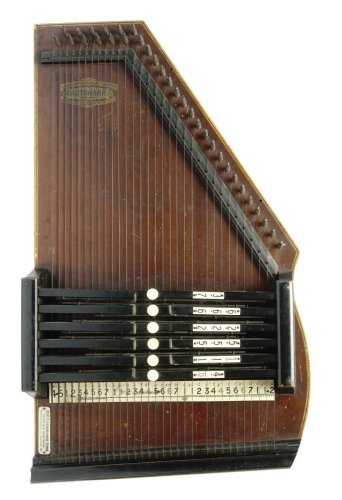
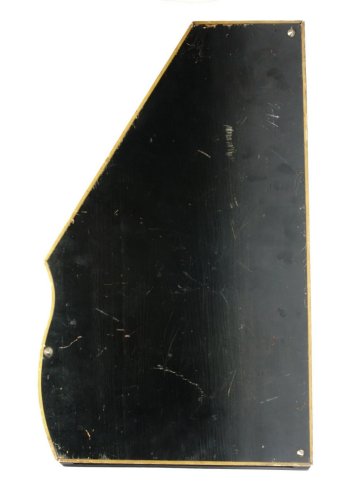
Modele DeLuxe
This is a Modele DeLuxe, which has 32 strings and six bars. It was capable of playing 16 different chords, by means of "shifters" which converted some of the chords from major chords to minor and/or dominant 7th chords.
This one was made at the Dolgeville, New York plant sometime in the 1890's. A similar model that was painted the familiar "Zimmermann Black," called the Model 6, was also available.
This was purchased on ebay.
Table Autoharps
These are autoharps that are constructed "backwards," so a right-handed person can play them when they are placed on a table or in the lap.

ChromAHarp Caroler
This was an interesting autoharp. It never really took off. It has 43 strings and plays 27 chords. There is also a "mute" bar to stop the sound of all the strings.
These instruments had a number of disadvantages. The chord bars were very noisy. The buttons were very close together. Also, the odd construction of the chord bars made it very difficult to change the chord layout to any of the more modern ones.
The chord bars were notched so that they were basically "permanent." You couldn't just recut the felts. In fact, they did not even use felt to mute the strings. They used some kind of rubber, something like neoprene.
The parts for these are very difficult to find. Basically, if you need parts, you should buy another Caroler.

Oscar Schmidt Attache
These were originally made with elementary school music teachers in mind. During the 1950's through the 1970's, there were traveling music teachers that went from school to school to teach children a little about music. Most schools did not have a piano in every classroom, so these autoharps were a great solution.
This particular one was probably made sometime around 1980. It has a "Made in USA" label. These are good instruments for people who want to play "Ozark style" with the autoharp lying on the table. A right-handed playe can play these without crossing hands.
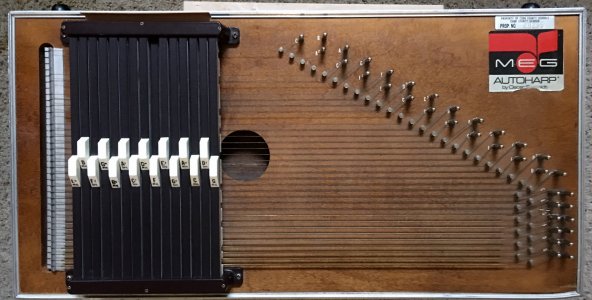
Oscar Schmidt MEG
MEG was an acronym for Music Education Group. It may only be a coincidence that the wife of the owner of Oscard Schmidt, Inc., was named Meg. The Music Education Group made a special series of autoharps specifically to compete with the ChromAHarps that were seriously cutting into the Oscar Schmidt sales to schools. This instrument is probably a bit older than the Attache model pictured above. Is a 15 chord model.
Electric Autoharps

Oscar Schmidt Lancer
This is a rather rare instrument. It's an Oscar Schmidt "Lancer." It has a built-in pickup. It is rather heavy. This particular one has a set of Schreiber fine tuners. This instrument was made about 1970 or so. There was also a two pickup version called "The Cutlass." They were a bit pricey for the market, so they were discontinued rather quickly.

Electric ChromAHarp by Sekova
Possibly even rarer than the Lancer is this electric ChromAHarp by Sekova. The tuners are actually geared tuning keys similar to those found on a guitar. There is just one minor problem. There is a special tuning wrench that is completely different than any other tuning wrench on any other autoharp. So, until I can manufacture one myself, I'm pretty much stuck!
To return to the home page, click here.
All pages on this site © Bill Palmer. All rights reserved.
For permission to republish contact Bill Palmer at the above e-mail address.
| |